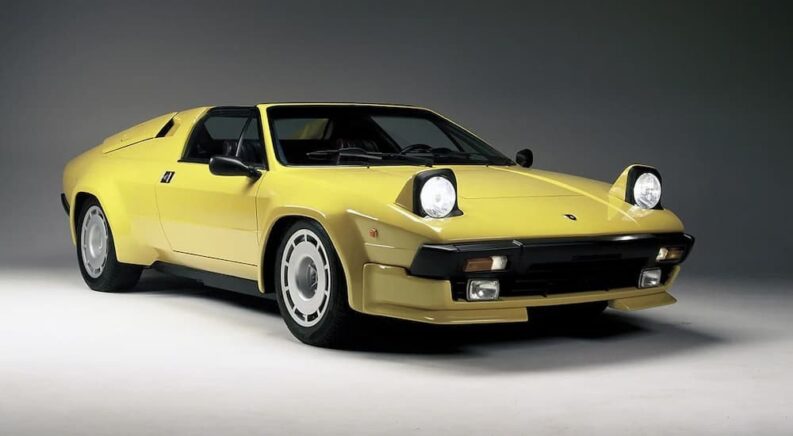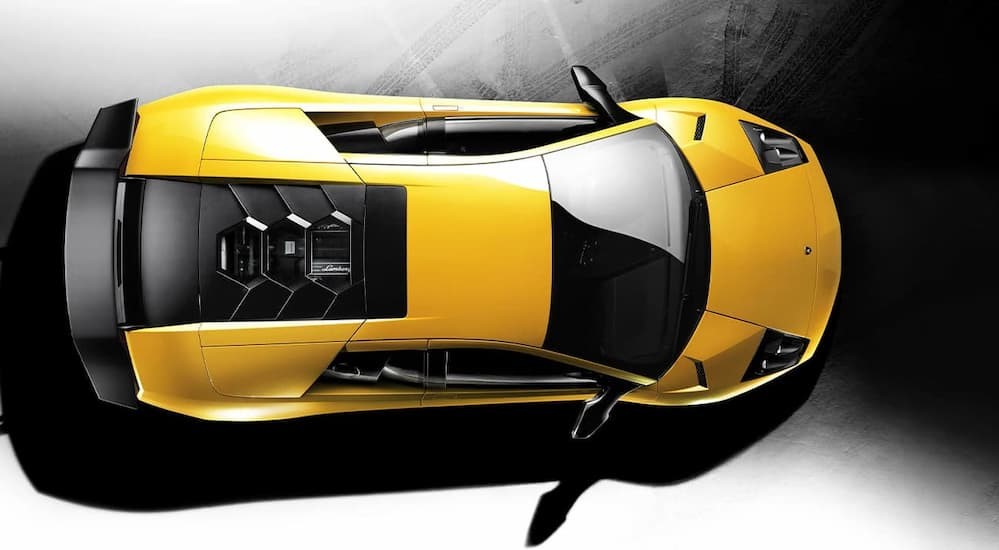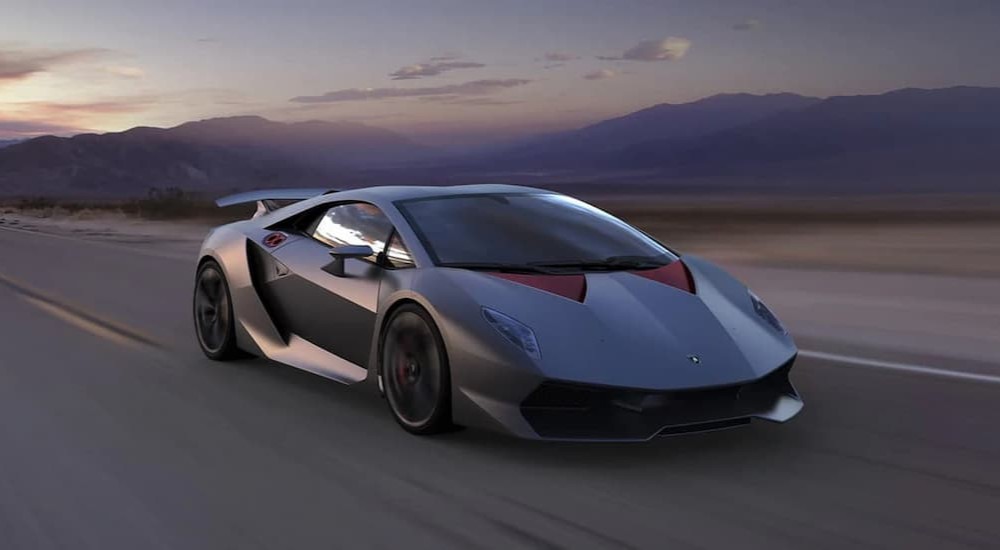Few automakers are more synonymous with performance and exclusivity than Lamborghini. The Italian brand has been crafting some of the world’s finest driving machines for over 60 years, but they’re not easy to come by. At an average cost of over a quarter million dollars (not including the $2.6 million Countach LPI 800-4), the Lamborghini lineup is the very definition of exclusive, but it’s not just the price that makes some of these models so rare. The brand is known for its one-off concept models and limited-run sports cars, making some of the best Lamborghinis almost impossible to find in the wild, let alone drive. We’ve collected five examples of Lamborghini’s most hard-to-find models in an attempt to drum up a little automotive envy. From Lamborghini’s most “affordable” model to a fighter jet on four wheels and a couple of cars that have probably singlehandedly depleted the world’s carbon fiber reserves, join us as we take you through a shopping list only a billionaire could love.
#1 – Veneno
50th anniversaries are usually celebrated with gold, but Lamborghini took a decidedly different approach when it came time to recognize its half-century on the market. With a base price of $4.5 million, the Veneno might as well have been made out of gold, but Lambo took a more lightweight approach with the 2014 model, employing carbon fiber at every turn. The Veneno’s monocoque, body panels, and interior were all crafted from the cutting-edge material, resulting in a 740 hp monster that tips the scales at just 3,200 lbs.
Limited to just 13 units (four coupes and nine roadsters), the ultra-exclusive Lamborghini was designed around a mid-mounted 6.5-liter V-12 that can speed the car from zero to 60 mph in 2.8 seconds while boasting a top speed of 220 mph. This sort of speed is made possible by the Veneno’s lightweight and slippery aerodynamic design that employs a forward-sloping front end, smooth underbody, and oversized rear diffuser to cut through the air at high speeds. The divided rear fenders and adjustable rear wing were inspired by the word of motorsports, with the latter enabling a unique interaction with the rear diffuser that produces enough downforce to keep all four wheels on the pavement when carving through the curves. A scintillating ode to 50 years of automotive excellence, the Veneno was an instant collector’s item and stands as the most expensive Lamborghini ever sold at auction when one model went for $8.3 million in 2019.
#2 – Jalpa
People don’t usually associate the Lamborghini brand with affordability, and there’s a good reason for that. That said, the Italian brand has made some value-oriented concessions to the masses with models like the Lamborghini Jalpa. Produced between 1981 and 1988, the Jalpa cost just $60,000, a figure that’s on par with a pearlescent paint job for the Countach LPI 800-4.
The Jalpa might be pretty mild by Lambo standards, with a 3.5-liter Lamborghini V8 producing just 255 hp and 225 lb-ft of torque, but this largely comes down to the fact that it was designed with comfort in mind. The Jalpa offers far better visibility than some Lamborghini models and is much easier to drive in heavy traffic and at lower speeds than its supercar cousins. The Jalpa holds the distinction of being the last V8 Lamborghini until the Urus SUV hit the market in 2018, and it is also part of a unique naming convention that is particularly well-suited to the Italian brand. The Jalpa, Gallardo, and Miura take their names from famous breeds of fighting bulls, while the Huracan, Diablo, and Aventador are named after specific bulls.
The Jalpa’s rarity comes down to its limited production run, with Lamborghini producing just 410 units in the eight years it was on the market. Although that is a seemingly low number, the Jalpa was actually Lamborgihni’s second-most successful V8 sports car after the Urraco. However, it was shelved when Chrysler took ownership of the brand in the late 1980s. While this is a rather rare Lamborghini, the Jalpa remains relatively affordable, with used models selling for around $90,000.
#3 – Murcielago SV
Every legendary car deserves an equally legendary send-off, and that’s exactly what we got with the Murcielago SV. Short for “SuperVeloce,” the SV brand is shorthand for a line of ultra-high-performance versions of the automaker’s already brawny models. Produced in 2010, the Murcielago SV capped off a decade-long run with a limited-edition supercar that took everything there was to love about the Murcielago and kicked it up a notch. From an upgraded V-12 that produces 661 hp to a steering system specifically tuned for high-speed fun and an optional six-speed manual transmission, the Murcielago SV was a fitting swan song for the super-powered sports car.
The SV is also 220 lbs lighter than the base Murcielago, with Lamborghini leveraging carbon-fiber panels and a slimmed-down exhaust system. The changes combine to give the Murcielago SV a zero-to-60-mph time of 3.1 seconds and a top speed of 213 mph, though that number does drop to 209 mph when you opt for the Aeropack wing. Most drivers will be happy to sacrifice four mph for the sort of downforce that makes ripping through even the tightest corner a no-muss, no-fuss affair. Lamborghini keeps all that power in check with a set of 15-inch carbon-ceramic rotors and six-piston calipers hiding behind glossy, 18-inch wheels.
Lamborghini planned to produce 350 units of the Murcielago SV, but far fewer are known to exist. Originally priced at $450,000, the Murcielago SV can now be found on the resale market for an average of $550,000, with one model bringing in $865,000 on Bring a Trailer in 2022.
#4 – Sesto Elemento
While the name might conjure images of an Italian sequel to everyone’s favorite 1997 Bruce Willis sci-fi blockbuster, the Sesto Elemento (“Sixth Element”) is almost as strange. Unveiled in 2010, the Sesto Elemento was intended to signal Lamborghini’s commitment to the increased use of lightweight materials, with the titular “sixth element” referencing carbon’s place on the periodic table. Liberal use of carbon fiber sees the Sesto Elemento weigh in at just 2,200 lbs, which, when combined with the 562 hp 5.2-liter V-10, gives the Lamborghini a power-to-weight ratio that’s tough to beat. A carbon-fiber body and chassis is nothing new in the supercar segment, but the Sesto Elemento takes it one unhinged step further by applying the ultralight material to the suspension and driveshaft.
The Sesto Elemento was more of a thought experiment than it was a full-fledged production model, though it was still a thought experiment that could rocket from zero to 60 mph in a speedy 2.5 seconds. With a spartan interior providing nothing but the essentials, the supercar certainly isn’t the most comfortable ride to emerge from Italy, but it sure is fast. The Sesto Elemento also lacks much of the safety equipment one would hope to find in a multi-million-dollar sports car. The model is both rare and impractical for most. Lamborghini only produced 20 units, and not a single one of them is legal to drive on US streets. Still, if you were looking for the ultimate collector’s item––and had $2.7 million to spare––why not treat yourself?
#5 – Egoista
While every Lamborghini takes some inspiration from founder Ferruccio Lamborghini’s Taurus astrological sign, the Egoista takes it to a whole other level. The V-10’s body is the very definition of “aggressive lines” with a space-age design that features protruding fenders that make the Egoista look like some sort of mecha-bull. If the Egoista’s central-seat, cockpit-like design seems familiar, there’s a good reason. The supercar was inspired by jet fighters, right down to the forward-opening canopy rather than traditional doors. This unique design means there is only room for the driver, but that makes a lot of sense when you consider that Egoista is Italian for “selfish.” Instead of a passenger, the space behind the driver is occupied by the 600 hp 5.2-liter V-10.
The Egoista sports a number of interesting features you’ll rarely find outside of a concept car. The one-seat cockpit certainly qualifies, as does the fact that––like in an F1 car––the steering wheel needs to be removed to make room for the driver. The real showstopper is the Egoista’s active aerodynamic panels that automatically adjust to changing conditions and driving styles.
While it might not fit in with the name, Lamborghini has been generous when it comes to allowing fans access to this on-off concept model. Simply buy a ticket to the automaker’s Museo Lamborghini in Sant’Agata Bolognese, Italy, and you’ll get the chance to gawk at this $117 million automotive masterpiece. It goes without saying that the Egoista isn’t street-legal, and it’s probably a good thing because we can only imagine how many accidents it would cause due to rubbernecking alone.
Automotive Artwork
With their price points and exclusivity, some of these Lamborghini models are as much a work of art as they are a way to get around town. While the average driver might not have the opportunity––or bank account––to get behind the wheel of these automotive sculptures, they’re still easy to appreciate from a performance and design perspective. Cars like the Egoista are more of an R&D exercise than full-fledged production models, giving Lamborghini the opportunity to test out bold new ideas like active aerodynamic panels and canopy doors. The Sesto Elemento is basically a $2.7 million press release in car form, telegraphing Lambo’s intention to increase its use of carbon fiber in the loudest way possible. The ostentatiousness is almost the point when it comes to the Lamborghini brand as a whole, but as strong believers in the automotive arts, we’re certainly not complaining.






